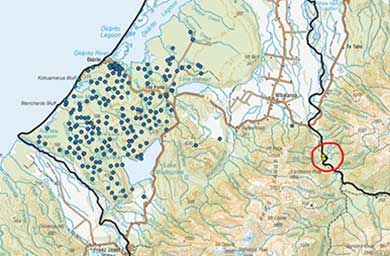Rangers with the Predator Free South Westland project spotted the kiwi on recently analysed trail camera footage in the Whataroa River area, about 15 kilometres away from where most of the kiwi live, in the Ōkārito Forest.

Rowi spotted on trail camera footage about 15 km from where most of the kiwi live
Image: DOC
DOC Principal Science Advisor Hugh Robertson says the rowi has most likely "moved" to the Whataroa River area because "home" at Ōkārito is getting busy.
"The fantastic work done by DOC's Franz Josef staff increased the population from about 160 birds in the early 1990s to over 600 birds by 2022, and the population continues to grow.
"With the population pressure building in Ōkārito, they are now spreading their tiny wings and wandering further afield in search of their own territory."
In the past, management of the kiwi population focused on efforts to grow the population by removing eggs from the forest for safe hatching and rearing.
But now that Ōkārito forest is part of the Predator Free South Westland project, kiwi are able to raise their own chicks into adulthood. This has resulted in population growth, and the expansion of kiwi habitat.
Fortunately, the area the kiwi has moved into is also part of the Predator Free South Westland project area, which is managed to stop re-incursion of stoats, rats and possums, making it better habitat for kiwi.
Duncan Kay, Operations Director for Zero Invasive Predators (ZIP), who manage the Predator Free project says, "ZIP is maintaining about 85,000 hectares as predator-free in South Westland, and the mahi of the last four years is bearing fruit.
"This is the predator-free dream becoming a reality - seeing birds like rowi not just surviving, but spreading out and being comfortable in the landscape that is their natural home."
DOC Avian Avoidance Trainer Anya Kruszewski is keen for people who live in the area with dogs to enrol in upcoming kiwi avoidance training.
"As the area where kiwi live grows, and as kiwi are exploring, there are more opportunities for dogs to be in contact with kiwi. Any dog is capable of killing a kiwi, and avoidance training can help reduce this risk, though dogs always will need close supervision in areas where kiwi are found."
Visit the Kiwi Avoidance Training website to register for a course in South Westland. The first course is coming up this Thursday 17 October: Kiwi Avoidance Training
Background information
Rowi had declined to a single population of just 160 birds in the 1990s, when efforts to prevent their extinction started.
Since that time, the population has grown to more than 600 birds, mostly with the help of intensive breeding intervention programme Operation Nest Egg. Kiwi eggs are removed from their nests for safe hatching and rearing until they reach a safe weight of around 1.2kg and are returned to the wild.
In 2018, in response to growing rowi numbers in the Ōkārito forests, rowi were introduced to the Omoeroa ranges between Fox Glacier and Franz Josef, part of their historical distribution area.






